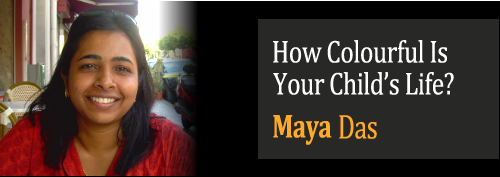How Colourful Is Your Child’s Life?
I have dabbled in colours ever since I can remember and as the years passed by, I realised they had various effects on my mental and emotional well-being. Education only ratified these feelings when I learnt that colours indeed have a big effect on your emotional and intellectual well-being.
Each colour signifies a mood and triggers an activity or emotion. When I had P, aside from the desire to introduce him to the world of colours for artistic reasons, I also made him play with colours for a reason. When we moved home, I knowingly infused various colours in the décor to bring out its therapeutic properties.
Addressing the basic question, ‘When do babies start seeing colours?’ Research says they can see colours at birth though they will have trouble distinguishing similar tones. Many babies prefer to look at black and white patterns or objects with high contrasts. The ability to distinguish colours develops rapidly, and as early as four months old some babies begin to show a preference for certain colours.
Colours are used widely in the West for healing and in therapy. Colour therapy is an accepted field of study and practice and it dates back centuries. Research has it that in ancient Egypt, people often immersed themselves in vats of coloured pigment as a curative measure.
So what does each colour signify? How to use them in our child’s life to enhance his/her learning and adding more colour to the joy of parenting?
The colour red, which is a favourite with many children including my P, is a warm and stimulating colour. It increases enthusiasm, creativity, kicks in energy and encourages action and confidence. I have a dash of red in P’s room to tickle his creativity and get him energised for learning. The flip side is that too much of red stimulates hyperactivity and irritability. Needless to explain why people see red when they are angry!
Blue is a soothing colour known for its cooling property. It induces a sense of calm and serenity in the child. Mentally, it aids the intuitive power of the brain. It is also said that having a little blue in the child’s room, like a blue night lamp or sky themed ceiling or simple blue P.Js, will help wind down the child and induce him to restful sleep sans nightmares (https://rosarydental.com/ativan-online/).
Yellow is a known happy colour. It triggers the happy and sunny hormones in our body hence promoting well-being and happiness in the child’s life. Yellow also activates memory, intellect and encourages communication. Having a yellow pencil, book or t-shirt while studying, goes a long way in making learning a happy and communicative experience. If you have a reluctant communicator, introduce him to the colour yellow!
The colour orange is the universal anti-depressant. It stimulates appetite, activity (like red) and encourages socialisation. Being close to the red family it is as much as an energiser as an agitator. Too much can prove to be a dampener. Having orange flowers (marigolds) around the house especially in your child’s room will chase the boo-boos away!
Green is again a relaxing colour like blue. It soothes frayed nerves and is helpful during times of anxiety and nervousness. Why do you think the doctors prescribe early morning walks in lush green gardens? Green is mentally and physically relaxing and rejuvenating. Taking your child to play in a green environment rejuvenates and relaxes him/her besides getting a daily dose of exercise. It is a perfect way to wind down after a busy day.
Brain research says that learning is optimised by yellow; beige and off-white, while red, orange and yellow spark energy and creativity. Now imagine the day of a child wearing a boring grey uniform, in an overly bright red environment told to do activities involving only blue and over dose of orange objects!
So the next time you are out shopping for clothes, vegetables or home décor or you are packing your little one’s lunch, give a little thought to the power of colours and infuse just the right amount of colours in his/her life to make their journey colourful.
A teacher to children with challenges by profession, Maya is an artist by passion. In her free time she dabbles in art with her preschooler son. You can follow their arty journey on artwithp.wordpress.com
